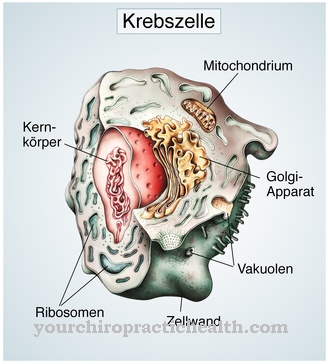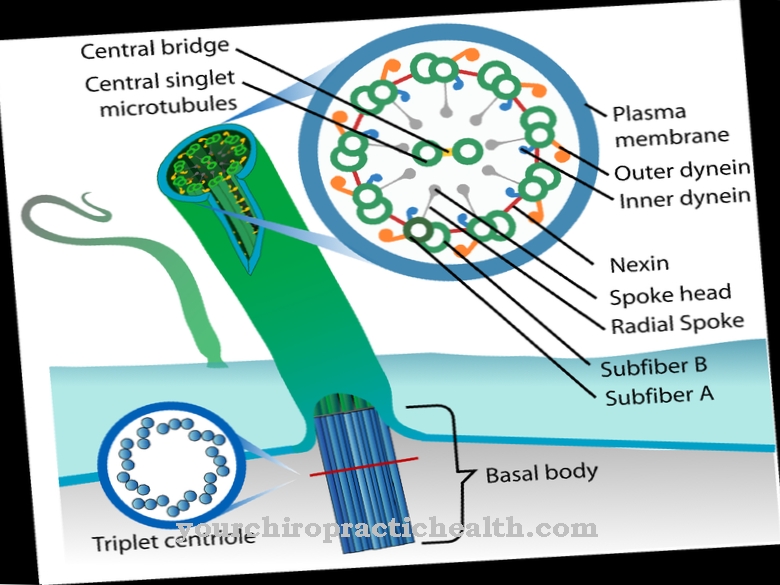Under one Hydrocele, also Water break called, one understands a change in the testicle, which is benign and usually occurs without pain. Water collects in the scrotum.
What is a hydrocele?
.jpg)
© Balint Radu - stock.adobe.com
A Hydrocele can only occur on the testicles and / or on the spermatic cord. There is both a primary, i.e., congenital, hydrocele, and a secondary, i.e. acquired, hydrocele. This can therefore arise in the course of life through different causes.
The primary hydrocele can occur on one or both sides and often regress in the first few months of life without treatment. Such a congenital water break is not uncommon.
There is also a special form of the hydrocele, the acute water break. It can be caused by trauma, hemorrhage, or infection. This form differs from the other two in the form of severe pain.
causes
The causes of the Hydrocele are of different types. In the primary hydrocele, the cause can be traced back to a developmental phase in the womb. The peritoneum extends into the scrotum in the shape of a funnel, takes place in the body of the unborn child and later regresses. Water can then collect there, creating a hydrocele.
The child's testicles do not come down from the abdominal cavity into the scrotum until shortly before birth or within the first year of life. They have to slide through the mentioned protuberance, which normally closes afterwards. If this is not the case, a hydrocele can form there or, if the closure fails completely, an inguinal hernia (inguinal hernia).
The secondary hydrocele can affect male children or adults at some point in life. There are several triggers for this, such as inflammation of the testicles or epididymis (see epididymis). In addition, injuries or testicular tumors can lead to a hydrocele. Hydroceles can also develop after an operation to remove varicose veins from the testicles (varicoceles).
Symptoms, ailments & signs
A hydrocele can have very different symptoms. A swollen testicle is typical of the disease. The extent to which the testicle is swollen depends primarily on the location and extent of the fluid accumulation.
In the early stages, the hydrocele usually does not cause any further symptoms. Only with the enlargement of the testicle do other symptoms appear, such as throbbing pain or a feeling of pressure or heaviness. In a severe course, an acute scrotum occurs, which is associated with severe pain. An acute water burst can lead to severe swelling of the testicle.
There is also an increased risk of developing infertility. Many people also notice a throbbing sensation in the scrotum area. Externally, a hydrocele can primarily be recognized by the swelling of the testicle. In severe cases, bleeding can also occur, which is manifested by a partial red color of the scrotum.
Congenital hydrocele occasionally resolve on their own. However, a water rupture or an inguinal hernia can also occur, which can cause serious complications. In the most severe case, the affected testicle dies.
Diagnosis & course
The diagnosis is made Hydrocele with the help of various examinations, the first with scanning by the doctor. This determines whether the scrotum is swollen and whether there are other external abnormalities. Usually an ultrasound examination is carried out to confirm the hydrocele.
The course of a hydrocele is generally positive, as it is a benign change in the testicle. The primary hydrocele can mostly resolve on its own and no treatment is necessary. In the case of the secondary, however, the cause should be treated. Surgery may also be needed if the hydrocele persists. The prognosis is nevertheless positive.
Complications
In most cases, the water break does not lead to any particular complications or complaints. The change in the testicle is benign and there is usually no pain in the patient. The testicles are relatively swollen and fill with water. Without treatment, pain in the testicles can occur as the disease progresses, although this does not primarily occur.
Pain in the testicles is a very unpleasant symptom for men and can lead to a severe reduction in quality of life. The affected person appears knocked out by the waterfall and no longer actively takes part in social life. Furthermore, psychological complaints and depression can develop if the water break is not treated. Pain at rest can also lead to sleep disorders at night.
In many cases no treatment is necessary. However, if the water breach does not resolve on its own, surgery can also take place to resolve the symptoms. There are no particular complications. The life expectancy of the patient is also not affected by the waterfall.
When should you go to the doctor?
A hydrocele must always be examined by a doctor. Since the degeneration can turn into a malignant tumor, early diagnosis and treatment of the disease always has a positive effect on the further course and can prevent complications. A doctor should always be consulted about the hydrocele if there is swelling of the testicles. This swelling mostly occurs without a specific reason and is permanent.
There is usually no pain. Accumulations of water can also be seen on the testicles. Only in rare cases do you experience pain or other unpleasant feelings in the testicles. If the symptoms of the hydrocele occur over a longer period of time and do not go away on their own, a visit to a urologist is definitely necessary. Treatment also usually takes place at the urologist and can completely limit the hydrocele. The life expectancy of the patient is not negatively affected by this disease.
Doctors & therapists in your area
Treatment & Therapy
If in the congenital Hydrocele If an inguinal hernia is not still present, the affected child does not initially need any treatment, as the water retention recedes by itself. If the water break has not resolved by the end of the first year of life, an operation is necessary.
This is only a minor procedure in which an incision is made in the groin to close the connection between the peritoneum and the scrotum. In the worst case, a hydrocele will form again after a few months, but this rarely happens. In the case of secondary hydrocele, therapy is used to treat the cause. As a result, the water retention can often recede.
If the water break persists or if there is no clearly identifiable cause, an operation is also recommended here to eliminate the symptoms. A special technique is used to prevent the hydrocele from forming again.
You can find your medication here
➔ Medicines for painOutlook & forecast
The majority of patients diagnosed with hydrocele can expect improvement. Statistically, it has been determined that nine out of ten patients experience a resolution of typical symptoms. Life without restrictions is the rule. A distinction must be made between two risk groups: small children up to the age of two and all others. The baby's illness usually heals on its own. The others need surgical therapy.
Toddlers are in constant evolution. This means that the origin between the testes and the abdominal cavity closes by itself. Often this happens around the fourth month of life. From the age of three, there is only one surgical intervention. This usually runs without complications. Possible difficulties are also known from other interventions: infections, swellings and others. The water break rarely returns.
If there is no intervention, complications regularly arise. For example, a permanent inability to conceive is possible. Fluid in the scrotum then squeezes the blood flow. Testicular torsion is also conceivable, in which the testicle disrupts blood flow. In any case, the genital area is very sensitive. Pain occurs increasingly in everyday life.
prevention
One can Hydrocele do not prevent directly; one can only try to keep the risk of its occurrence as low as possible. Anyone who suffers or has suffered from an inflammation of the testicles or epididymis, for example, should consistently treat them with medical advice. Anyone who practices certain types of sports that have an increased risk of genital injuries should protect themselves adequately. For example, there are genital protectors for athletes that could be put on.
Aftercare
Following an operation, the patient usually remains in the clinic for one to two days to ensure the necessary follow-up care. This consists of removing the wound drainage tube on the day after the operation and inspecting the surgical wound. Occurring wound pain can be discussed with the doctor during the rounds and treated accordingly with medication.
Those affected must take it easy and avoid physical exertion in the first two weeks after discharge. Hot baths or full baths in general are taboo at this time; the shower should be used instead.Sauna visits or the use of hot water bottles or heating pads are also contraindicated within this time frame.
If there is no redness, swelling or pain, the wound will heal according to plan. Nevertheless, the patient is encouraged to arrange a check-up appointment with his urologist shortly after his discharge and to give him the discharge letter from the clinic. This contains all information about the treatment that has taken place and the medication administered.
The sutures begin to dissolve after two weeks and gradually fall off by themselves over a period of up to three months. If the suture is irritated or if there are still residues on the wound after this period, a doctor should be contacted.
You can do that yourself
A hydrocele usually requires surgery. Some home remedies and tips will aid treatment.
First of all, those affected should wait. Sometimes the blockage on the testicles clears up after a while and the fluid can drain away on its own. This process can be supported by a bath with Epsom salt. The warm water, in conjunction with the salts, ensures that the liquid is drawn out of the body through the skin and the swelling subsides. Epsom salt is also rich in magnesium, which relaxes muscles and relieves tenderness. However, if the hydrocele is painful, an Epsom salt bath can cause further inflammation. If you are in pain, it is best to get medical help.
After the recovery period, rest and warmth are recommended. Children should spend as much time in bed as possible for the first two days after treatment. Men should not engage in sexual activity for at least a week. Finally, the scrotum and especially the area around the water break should be spared. Protective underwear or a bandage protect the irritated area from further stress and help with recovery.




.jpg)








.jpg)

.jpg)
.jpg)











.jpg)